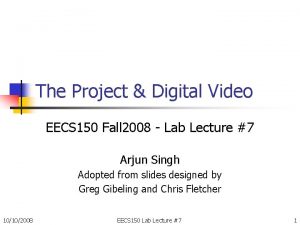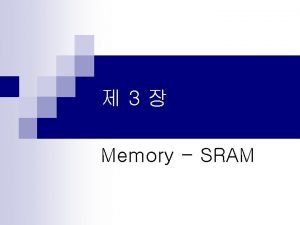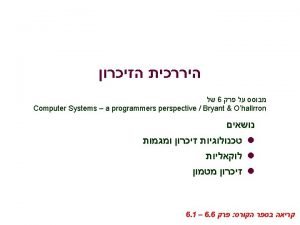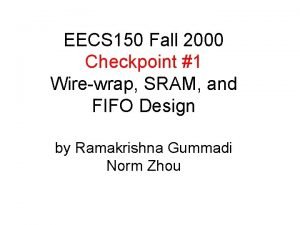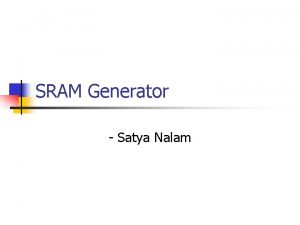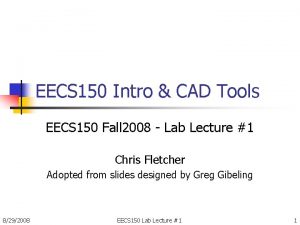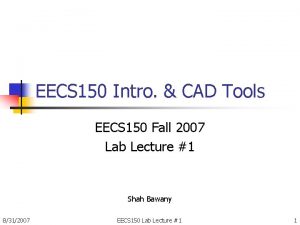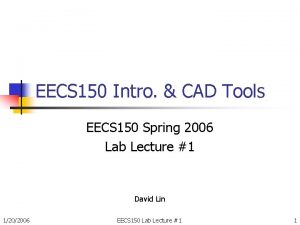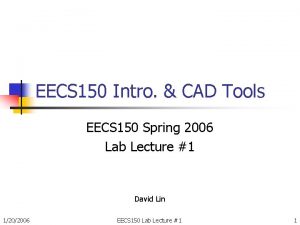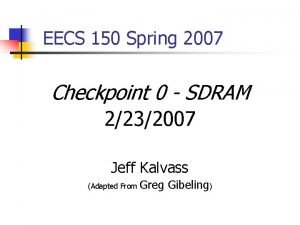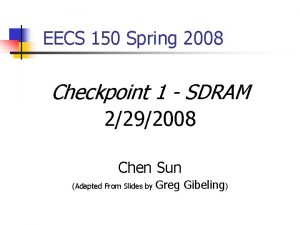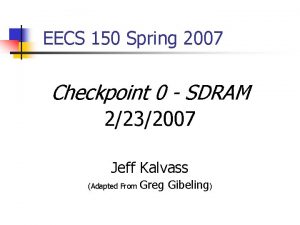EECS 150 Fall 2000 Checkpoint 1 Wirewrap SRAM











- Slides: 11

EECS 150 Fall 2000 Checkpoint #1 Wire-wrap, SRAM, and FIFO Design by Ramakrishna Gummadi Norm Zhou

Goals of the Lab • Learn to do wire-wrap • Wire an SRAM to the Xilinx on the design demonstration board, test and debug it • Learn another interesting application of LFSRs in generating and verifying test patterns • Build the FIFO as a component that is going to be used later in the project

Using Wire-wrap • You should have picked up a kit containing this tool from the TAs Wrapping End Unwrapping End Hole for Pin Wire Stripper Hole for Wire Slot for Wire

Making a Wire-wrap Connection • Plan the route of your wire • Cut the wire ~ 2. 5 inches longer than the route you choose • Strip an inch of insulation off each end • Insert a stripped end of the wire into the off-center hole in the end of the wrapping end of the tool • Put the wrapping end of the tool on the pin to be connected • Gently, without pushing down, or lifting up, twist the tool clockwise about 12 revolutions • DO AS MUCH OF THE WIRE-WRAP WORK AS POSSIBLE BEFORE COMING TO THE LAB

SRAMs • Very fast, simple, more expensive than DRAM • We use W 24512 AK that: – Has 8 data pins – 16 address pins – Can put out data in 15 ns • NOTE: the Xilinx pin assignment is different for this lab than the previous years’ labs

Reading/writing From the SRAM • Reading is easy: – Just assert OE and read the data line • Writing, however, is a tricky: – Problem is, writes are asynchronous – Address and data line should stay stable, and not just on the clock edges Cycle 1 ADDR DATA WE Cycle 2 Cycle 3

Testing SRAM • How do we know whether the SRAM is working correctly? – Write test vectors into SRAM memory, read them back, and test if they match • Two approaches to generating test vectors: – Use specific patterns – Use a brute-force approach • We use the latter, except that we are a bit clever in the data we stick into the SRAM: – We use LFSRs to generate the data – Good, because we do not need to store the original patterns, and we can randomly test for all patterns

FIFOs • Abstractly, fifos are like queues: you can enqueue elements into them, and dequeue them later, but only in the order in which they were enqueued (hence, the name) • Can be implemented using two counters (head and tail), and a piece of SRAM • In this class, however, the SRAM block is external to the FIFO

Better FIFOs • Along with the “head” and “tail” pointers, we also have more control signals out of the fifo • The fifo can use the control signals to indicate its state ADDR[14: 0] Read Write FULL FIFO EMPTY HALF_FULL • This fifo is 32 -K words deep

Notes on FIFO Design • Since the SRAM is outside the FIFO, you need to route FIFO-generated addresses to SRAM address pins • Recall that a FIFO has two counters, a head and a tail – Which counter’s contents do we put out? – Answer: use a MUX or a tri-state buffer to determine whether a FIFO is being read or written

Putting It All Together Read LFSR=DIN Reset_LFSR FIFO Write FSM FULL Enable_LFSR EMPTY LFSR & Comparator DOUT[7: 0] DIN[7: 0] OE WE CE IO BLOCK ERROR ADDR[14: 0] ADDR 15 0 • The LFSR generates data for testing • You must design the shaded parts • NOTE: the OE, WE, and CE, are all active high externally

